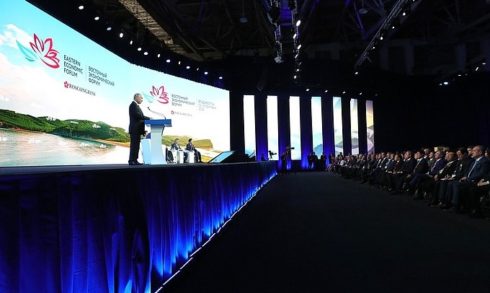Written by Arkady Savitsky; Originally appeared on strategic-culture.org
The Eastern Economic Forum (EEF) was held in Vladivostok on Sept.11-13. Founded in 2015, the event has become a platform for planning and launching projects to strengthen business ties in the Asia-Pacific region.
This year, the EEF brought together delegations from over 60 countries to discuss the topic “The Far East: Expanding the Range of Possibilities”. A total of 100 business events involving over 6,000 participants were held during the three days. 1,357 media personnel worked to cover the forum. Last year, the number of participants was 5,000 with 1,000 media persons involved in reporting and broadcasting. The EEF-18 gathered 340 foreign and 383 Russian CEOs. Nearly 80 start-ups from across South-East Asia joined the meeting.
This year, a total of 175 agreements worth of 2.9 trillion rubles (some $4.3 billion) were signed. For comparison, the sum was 2.5 trillion rubles (roughly $3.7 billion) in 2017. They included the development of the Baimsky ore deposits in Chukotka, the construction of a terminal for Novatek LNG at Bechevinskaya Bay in Kamchatka and the investment of Asian countries in Russia’s agricultural projects in the Far East. Russian Direct Investment Fund (RDIF), Mail.Ru Group, Megafon and Chinese Alibaba inked an agreement on establishing AliExpress trade joint venture. Rosneft and Chinese CNPC signed an oil exploration agreement.
The Chinese delegation was the largest (1,096 people), followed by the Japanese (570 members). The list of guests included the president of Mongolia and prime ministers of Japan and South Korea. It was also the first time Chinese President Xi Jinping attended the event to meet his Russian counterpart. The issue of de-dollarization topped the agenda. Russia and China reaffirmed their interest in expanding the use of national currencies in bilateral deals.
During the forum, Kirill Dmitriev, the head of RDIF, said the fund intends to use only national currencies in its transactions with China starting from 2019. It will cooperate with the China Development Bank. This “yuanification” is making visible progress with Shanghai crude futures increasing their share of oil markets up to 14 percent or even more. China has signed agreements with Canada and Qatar on national currencies exchange.
De-dollarization is a trend that is picking up momentum across the world. A growing number of countries are interested in replacing the dollar. Russia is leading the race to protect itself from fluctuations, storms and US-waged trade wars and sanctions. Moscow backs non-dollar trade with Ankara amid the ongoing lira crisis. Turkey is switching from the dollar to settlements in national currencies, including its trade with China and other countries. Ditching the US dollar is the issue topping the BRICS agenda. In April, Iran transferred all international payments to the euro.
The voices calling for de-dollarization are getting louder among America’s closest European allies. In August, German Foreign Minister Heiko Maas called for the creation of a new payments system independent of the US. According to him, Europe should not allow the United States to act “over our heads and at our expense.” The official wants to strengthen European autonomy by establishing independent payment channels, creating a European Monetary Fund and building up an independent SWIFT system.
Presenting his annual program, European Commission President Jean-Claude Juncker called on Sept. 12 for the European Union to promote the euro as a global currency to challenge the dollar. According to him, “We must do more to allow our single currency to play its full role on the international scene.” Mr. Juncker believes “it is absurd that Europe pays for 80 percent of its energy import bill – worth 300 billion euros a year – in US dollars when only roughly 2 percent of our energy imports come from the United States.” He wants the raft of proposals made in his state of the union address to start being implemented before the European Parliament elections in May.
70% of all world trade transactions account for the dollar, while 20% are settled in the euro, and the rest falls on the yuan and other Asian currencies. The dollar value is high to make the prices of consumer goods in the US artificially low. The demand for dollars allows refinancing the huge debt at low interest rates. The US policy of trade wars and sanctions has triggered the global process of de-dollarization. Using punitive measures as a foreign policy tool is like shooting oneself in the foot. It prompts a backlash to undermine the dollar’s status as the world reserve currency – the basis of the US economic might. The aggressive policy undermines the US world standing to make it weaker, not stronger.







It’s not only T. Rump behind this self-destructive policy of leveraging economic sanctions; pretty much every senator and congressman is too. They are delusional. It’s classic ’empire in decline’ stuff. The sooner, the better!
2.9 trillion rubles = $43 billion, not 4.3 ))
The press raves on about the low value of the ruble, and other currencies the US dislikes.
But really it’s the dollar euro pound etc that are over valued.
Based on the number of dollars the US has printed since it defaulted on the Bretton Woods agreement, gold should be worth about $30 thousand dollars US an ounce. They keep debasing the dollar, and other countries follow suit, because they want their currency to be lower than the US dollar.
Gold is the only money, everything else are just IOU’s.
Yes yes yes, dump the dollar, and end the tyranny.